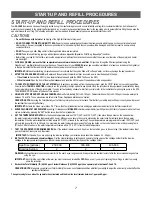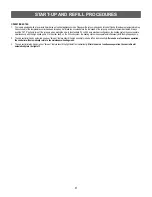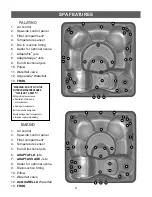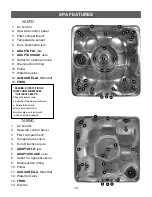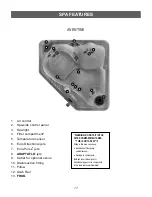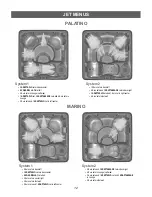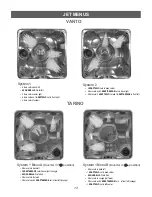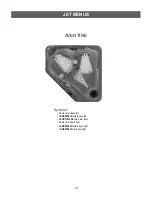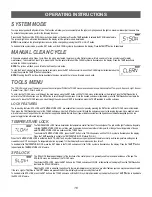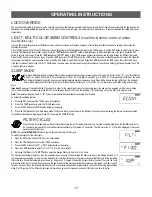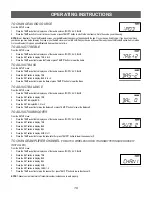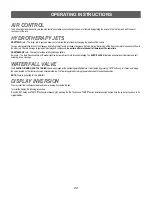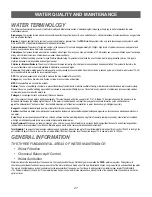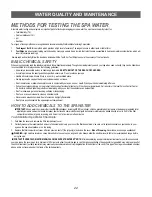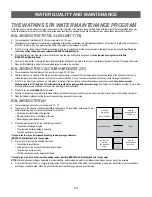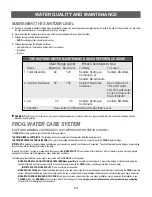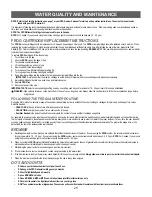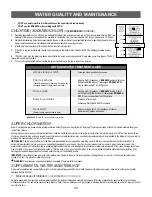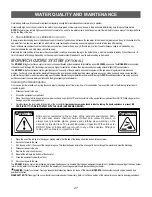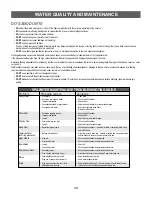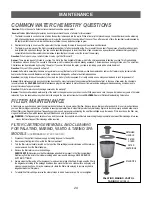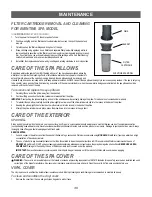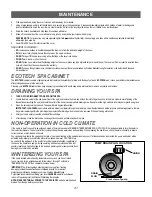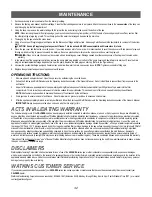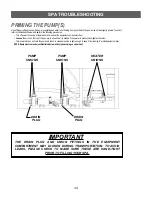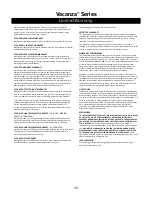
wATER TERMINOlOgY
The following chemical terms are used in this Water Quality and Maintenance section. Understanding their meaning will help you to better understand the water
maintenance process.
Bromamines:
Compounds formed when bromine combines with nitrogen from body oils, urine, perspiration, etc. Unlike chloramines, bromamines have no pungent odor
and are effective sanitizers.
Bromine:
A halogen sanitizer that is commonly used in stick, tablet, or granular form. The
FrOG
sanitizing system is the only solid bromine-approved system. See the
DO’s and DON’Ts of Spa Water Maintenance for additional information.
Calcium Hardness:
The amount of dissolved calcium in the spa water. This should be approximately 50-150ppm. High levels of calcium can cause cloudy water and
scaling. Low levels can cause harm to the spa equipment.
Chloramines:
Compounds formed when chlorine combines with nitrogen from body oils, urine, perspiration, etc. Chloramines can cause eye irritation as well as having a
strong odor. Unlike bromamines, chloramines are weaker, slower sanitizers.
Chlorine:
An efficient sanitizing chemical for spas. Watkins Manufacturing Corporation recommends the use of sodium dichlor-type granulated chlorine. This type is
preferred because it is totally soluble and nearly pH neutral.
Chlorine (or Bromine) residual:
The amount of chlorine or bromine remaining after chlorine or bromine demand has been satisfied. The residual is, therefore, the
amount of sanitizer which is chemically available to kill bacteria, viruses and algae.
Corrosion
: The gradual wearing away of metal spa parts, usually caused by chemical action. Generally, corrosion is caused by low pH or by water with levels of TA, CH,
pH or sanitizer which are outside the recommended ranges.
dPd:
The preferred reagent used in test kits to measure the Free Available Chlorine (FAC).
Halogen:
Any one of these five elements: fluorine, chlorine, bromine, iodine, and astatine.
MPS:
Monopersulfate is a non-chlorine oxidizer.
Oxidizer:
The use of an oxidizing chemical is to prevent the buildup of contaminants, maximize sanitizer efficiency, minimize combined chlorine and improve water clarity.
Ozone:
Ozone is a powerful oxidizing agent which is produced in nature and artificially by man. Ozone forms no by-products of chloramines (ozone actually oxidizes
chloramines) and will not alter the water’s pH.
Pathogen:
A microorganism such as bacterium that cause disease.
pH:
The measure of the spa water’s acidity and alkalinity. The recommended pH for the spa water is 7.2 to 7.8. Below 7.0 (considered neutral), the spa water is too
acidic and can damage the heating system. Above 7.8, the water is too alkaline and can result in cloudy water, and scale formation on the shell and heater.
ppm:
The abbreviation of “parts per million”, the standard measurement of chemical concentration in water. Identical to mg/l (milligrams per liter).
reagent:
A chemical material in liquid, powder, or tablet form for use in chemical testing.
Sanitizer:
Sanitizers are added and maintained at recommended residuals to protect bathers against pathogenic organisms which can cause disease and infection in
spa water.
Scale:
Rough calcium-bearing deposits that can coat spa surfaces, heaters, plumbing lines and clog filters. Generally, scaling is caused by mineral content combined
with high pH. Additionally, scale forms more readily at higher water temperatures.
Shock Treatment:
Also known as “super-chlorination” when chlorine is used. Shock treatment is a process of adding significant doses of a quick dissolving sanitizer
(sodium dichlor is recommended) to oxidize non-filterable organic waste and to remove chloramines and bromamines.
Total alkalinity:
The amount of bicarbonates, carbonates, and hydroxides present in spa water. Proper total alkalinity is important for pH control. If the TA is too high, the
pH is difficult to adjust. If the TA is too low, the pH will be difficult to hold at the proper level. The desired range of TA in spa water is 40 to 120 ppm.
gENERAl INFORMATION
ThE ThREE FUNdAMENTAl AREAS OF wATER MAINTENANCE:
• water Filtration
• Chemical balance/ph Control
• water Sanitation
Water sanitation is the responsibility of the spa owner. To properly sanitize the spa, Watkins highly recommends the
FrOG
water care system. This system will
chemically control the bacteria and viruses present in the fill water or introduced during use of the spa. Bacteria and viruses can grow quickly in undersanitized spa water.
The water’s chemical balance and pH control are also the responsibility of the spa owner. You’ll have to add chemicals to maintain proper levels of Total Alkalinity
(TA), Calcium Hardness (CH) and pH. Proper water balance and pH control will minimize scale buildup, extend the life of the spa, and allow the sanitizer to work at an
optimum level.
WaTer QUalITY aNd MaINTeNaNCe
21
Summary of Contents for PLT1S1001
Page 1: ...VACANZA SERIES 2 0 1 4 O W N E R S M A N U A L ...
Page 39: ......

